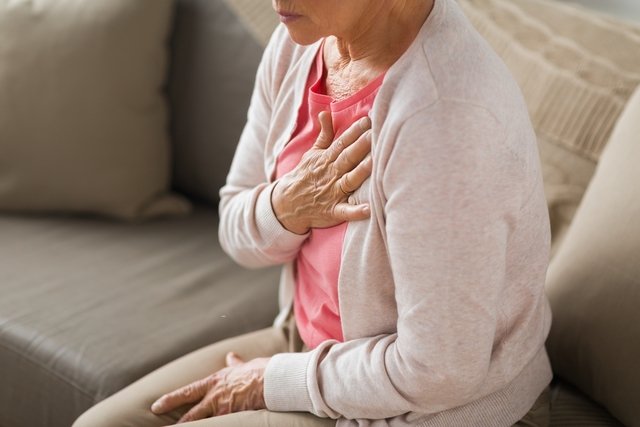A fulminant heart attack is one that appears suddenly and can often cause sudden death, which can occur 1 to 24 hours after the onset of symptoms, such as chest pain that can radiate to the arm, shortness of breath or cold sweat , for example.
This type of heart attack occurs when there is an abrupt interruption of blood flow to the heart, and is generally caused by genetic changes, which cause changes in the blood vessels or a serious arrhythmia. The risk of a massive heart attack is higher in young people with genetic changes or risk factors for heart disease, such as smoking, obesity, diabetes and high blood pressure.
Due to its severity, a fulminant heart attack can lead to death if it is not promptly diagnosed and treated. Therefore, in the presence of symptoms that may indicate a heart attack, such as chest pain, a feeling of tightness or shortness of breath, for example, it is very important to seek medical attention as soon as possible.
Understand better about heart attacks, with Dr. João Petriz, in the following video:
Symptoms of fulminant heart attack
The main symptoms of a fulminant heart attack are:
- Pain, heaviness or burning sensation in the chest, which may be localized or radiate to the arm or jaw;
- Feeling of indigestion;
- Intense shortness of breath;
- Sudden tiredness;
- Cold sweat.
Although a fulminant heart attack can appear without any prior warning, symptoms can appear days before and not just at the time of the attack.
The intensity and type of symptom that appears varies according to the severity of the damage to the myocardium, which is the heart muscle, but also according to the person’s characteristics, as it is known that women and diabetics have a tendency to present quieter heart attacks. Find out what the symptoms of a heart attack are like in women.
It is important to seek medical help immediately or the nearest emergency room if symptoms of a fulminant heart attack appear, as it is a serious condition that can be life-threatening.
Don’t ignore the signs your body is giving you!
What to do in case of a fulminant heart attack
Until treatment is carried out by a doctor in the emergency room, it is possible to help a person with a massive heart attack, and it is recommended to call a SAMU ambulance by calling 192, or take the victim immediately to the hospital.
While waiting for the ambulance, it is important to calm the person and leave them in a calm, cool place, always checking consciousness and the presence of pulse beats and respiratory movements. If the person has stopped heartbeat or breathing, cardiac massage should begin. See how to do cardiac massage correctly.
Possible causes
Fulminant heart attack is caused by blockage of blood flow in the coronary arteries that irrigate the heart, by fatty plaques, resulting in death of cardiac tissue. Furthermore, a fulminant heart attack can also arise due to a malignant arrhythmia, which prevents the heart from producing electrical impulses necessary for the heart to beat.
These conditions cause the heart to be unable to pump blood to the body and deliver oxygen to the tissues, which results in the appearance of symptoms.
Who is most at risk
Some factors increase the risk of developing a fulminant heart attack, such as:
- Family history of heart attack;
- Age over 45 years;
- High levels of stress;
- High pressure;
- Diabetes;
- High cholesterol;
- Overweight or obesity;
- Smoking;
- Excessive consumption of alcoholic beverages.
Although these people are more predisposed, anyone can develop a heart attack, therefore, if symptoms indicate this situation, it is very important to go to the emergency room for confirmation and treatment as soon as possible.
Fulminant heart attacks occur especially in young people, as they do not yet have the so-called collateral circulation, responsible for irrigating the heart together with the coronary arteries. Lack of circulation and oxygen causes the heart muscle to suffer, causing chest pain, which can later result in death of the heart muscle.
How the treatment is carried out
The treatment of a fulminant heart attack is carried out in the hospital, with the doctor recommending the use of medicines to improve blood circulation, such as acetylsalicylic acid, as well as surgical procedures to reestablish the flow of blood to the heart, such as catheterization. Find out how cardiac catheterization is performed.
If the heart attack leads to cardiac arrest, the medical team will begin a cardiopulmonary resuscitation procedure, with cardiac massage and, if necessary, the use of a defibrillator, in an attempt to save the patient’s life.
Furthermore, after recovery, it is important to begin treatment to rehabilitate physical capacity after the heart attack, with physiotherapy, after approval from the cardiologist. Check out more details about the treatment of acute myocardial infarction.
How to prevent a heart attack
To reduce the risk of having a heart attack, it is recommended to practice some type of physical activity regularly, such as walking for 30 minutes at least 3 times a week. Another important tip is to drink plenty of water and avoid stress by taking time to rest. Check out other tips to reduce the risk of a heart attack or stroke.
Furthermore, it is also recommended to maintain a healthy diet, giving preference to the consumption of vegetables, grains, whole grains, fruits and lean meats, such as chicken, fish and tofu, for example.




